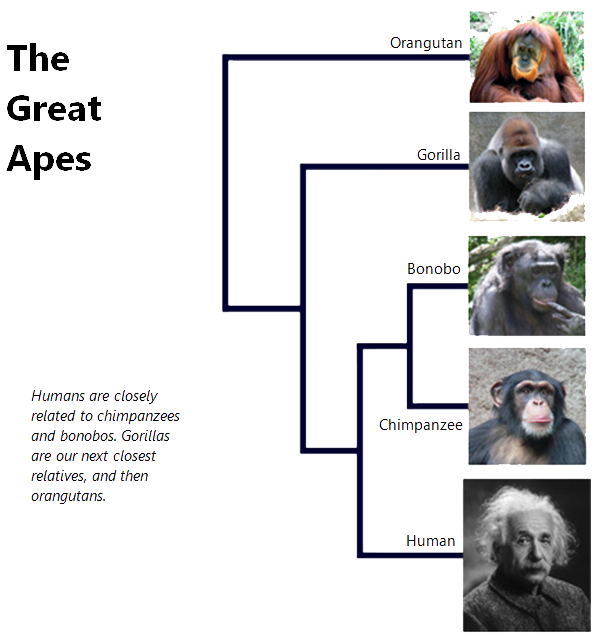4.3 The Great Apes
The great apes belong to the family Hominidae (also called the hominids). This includes orangutans Pongo abelii (Sumatran orangutan), Pongo tapanuliensis (Tapanuli orangutan), and Pongo pygmaeus (Bornean orangutan, and probably the most well-known). Pongo pygmaeus also has three subspecies: P. pygmaeus pygmaeus, P. pygmaeus morio, and P. pygmaeus wurmbii. There is continues to be debate among primatologists and other scientists whether orangutans should remain in Hominidae. Some argue they are distinct enough from the other apes that they should have their own family – Pongidae.
Gorillas are also part of Hominidae, and include two species, each of which have two subspecies. The western gorillas (Gorilla gorilla) diverge into G. gorilla gorilla (western lowland gorilla, and probably the most well-known) and G. gorilla diehli (cross river gorilla). These subspecies diverged approximately 18,000 years ago. The eastern gorillas (Gorilla beringei) were listed as subspecies of G. gorilla until 2001, when they were categorized into their own species and two subspecies – G. beringei graueri (Grauer’s gorilla) and G. beringei beringei (Mountain Gorilla).
Diverging from Hominidae, the subfamily Homininae consist of chimpanzees, bonobos, and humans. Within Homininae there are two tribes – panini and hominini. Panini includes the genus Pan and includes Pan troglodytes (chimpanzees) and Pan paniscus (bonobos). There are four subspecies of P. troglodytes – P. troglodytes versus (western or masked chimpanzee), P. troglodytes troglodytes (Central African or black-faced chimpanzee), P. troglodytes schweinfurthii (East African or long-haired chimpanzee), and P. troglodytes vellerosus (Nigeria chimpanzee). Bonobos (Pan paniscus) used to be listed as a subspecies of P. troglodytes because of their close anatomical similarity to chimpanzees. However, as more gracile, docile, and reduced sexual dimorphism, they were listed as their own species in 1929.
The only living species in the tribe hominini is Homo sapiens, us. These are the hominins (of direct ancestral connection to humans). Though there is a long, evolutionary history dating to the split of the genera Pan and Homo, anthropologists and primatologists are not aware of any other Homo species living today. This is important! It means that the wide diversity of humans – morphology, mating and parenting strategies, ecology, and more – represents an incredible amount of variation in a single genetic population. That’s pretty cool.

This close evolutionary relatedness is what allows us to reference chimpanzees and bonobos when hypothesizing about the behavior of ancestral hominins. Our last common ancestor with tribe panini is less than seven million years ago. While this sounds like a long time, that is an evolutionary blink of the eyes. Therefore, we can look to bonobos and chimpanzees to understand the apeness in our own behavior – even today.

